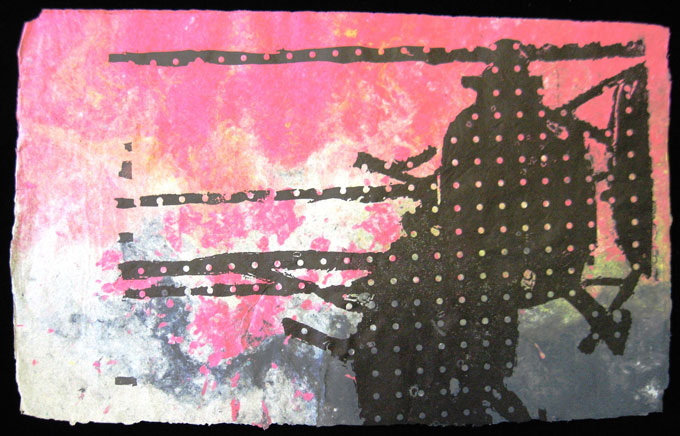
Drew Matott, Peg Board Chopper, 2008. Woodcut on pigmented Combat Paper. Initiated by Drew Matott and Drew Cameron, the Combat Paper Project is a collaboration among veterans to express their experiences with the military by reclaiming their uniforms as art through a transformative process of papermaking.
There are many stigmas associated with veterans returning from combat. We are all presumed to suffer from some form of post-traumatic stress, and many believe we simply don’t have the capacity to properly assimilate back into society. This assumption can be especially difficult for those of us who enlisted in the military to be part of something larger than ourselves—and who consider art-making and creative expression a continuation of, rather than a release from, service.
Because most people see the military and the arts as two very different worlds, they assume I am pursuing the arts because it serves as a kind of therapy, preparing me for reintegration or allowing me to express years of traumatic experiences. While those realities surely exist for many veterans, that very assumption creates a bias that is incredibly difficult to overcome. The truth is that many military service members are creative individuals who continue to innovate, serve in their communities and use the arts to communicate a unique veteran perspective.

Drew Matott, Deployed, 2010. Relief print on Combat Paper.
In 2009, I returned to the arts after eight years in the military, during which I was deployed four times for Operation Enduring Freedom. Although I had been out of the arts scene for nearly a decade, I was by no means new to it. I had been a musician and performer all of my life. I was excited to reconnect with my love of the arts, but I was especially struck by meeting so many other veterans who had similar stories of putting their love of the arts on hold to serve. So I approached the programming director of a small community arts organization in Baltimore and shared my idea for a showcase in which veterans from different disciplines would present their creative skills. I will never forget the director’s response: “I don’t know—veterans tend to be long-winded.”
I believed the programming director in Baltimore sincerely wanted to highlight veteran experiences for her community, but I knew it would be an uphill battle to do so on my community’s terms. We were being boxed in, once again. I realized then the next battle I was meant to fight: bridging the gap for veterans between a life in the military and a career in the arts.

Drew Matott and Dick Iacovella, What We Left Behind, 2010. Pulp painting and pulp printing on Combat Paper.
Many organizations help veterans to express themselves and address issues related to combat and reintegration through art. But sometimes veterans are simply looking for mentorship and networking opportunities to transition into a career in the arts. The tension between art as a creative practice and art as therapy often becomes a barrier for veterans seeking to work in the arts. Many veterans are creating art works unrelated to their military experience and don’t want the creative community or society at large to assume they are wounded or ill.
The value of veterans in the arts is not just about veterans; it gives the civilian population the opportunity to understand the veteran experience. Less than one percent of the American population has served in Afghanistan or Iraq since the September 11 attacks. This extreme gap in perspective is driving assumptions about veterans that are often perpetuated by the arts and entertainment industry. Giving veterans the tools, training and access they need to work in the arts community gives a voice to a population that is too often the subject of media misrepresentation.

The Veteran Artist Program’s “Operation Oliver” mural in Baltimore, Maryland. Photo by Josh Davidson, 2011.
The arts have always been the best way for members of a society to understand one another, communicate the value of change and transform the world in which we live. I am privileged to have an incredible platform, the Veteran Artist Program, to share my experience and consider the roles for veterans in the arts. The challenge is answering the question, “What’s next?”
The answer is twofold. Veterans have to take care of each other, out of mutual trust and a shared understanding of our collective experience. At the same time, we need the mainstream arts community to embrace veteran artists and invest in the belief that this generation of military veterans is not only comprised of warriors but also represents a new creative class capable of transforming the arts in America.
This piece, commissioned by Creative Time Reports, has also been published by The Daily Beast.

